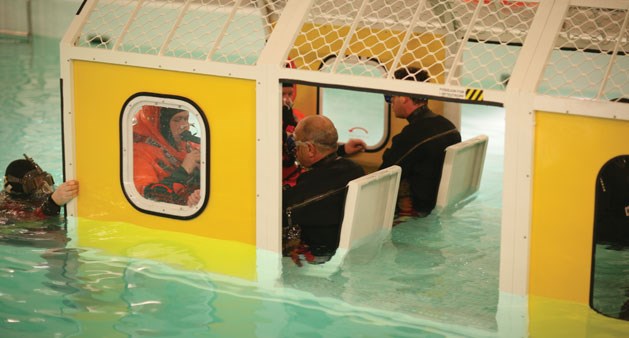INEOS is obsessive when it comes to safety. But when you work in a high-risk environment, you cannot afford to be complacent. Safety runs through the very heart of all that INEOS does. But INEOS-owned Norward AS exists for one reason alone. And that’s to save lives, as Øyvind Klæboe knows only too well.
In August 2003 an Indian helicopter ferrying 25 offshore rig workers nose-dived into the sea, its blades still spinning.
The crew, still strapped in their seats, died as the helicopter sank in seconds. Only two passengers survived. They escaped by swimming out of the rear clamshell doors, and were rescued.
Both of them were also the only two to have undergone helicopter underwater escape training (HUET).
Tragedies like that remind Øyvind Klæboe why the work his team at INEOS-owned Norward AS in Norway matters. They have been teaching offshore workers how to escape in the event of a helicopter ditching in the sea for the past seven years.
“There is absolutely no doubt about the value of HUET,” he said. “Can it mean the difference between life and death? Absolutely.
“You literally have seconds to decide what to do in the event of a crash and, with training, you would have a much greater chance of survival.”
Mechanical failure, pilot error and bad weather can all cause a helicopter to crash.
A helicopter can fall out of the sky like a stone, spin horribly out of control or actually land quite gently.
Whatever happens, the key to survival is to get out as quickly as possible.
“You don’t know how long you have got before a helicopter turns over and sinks so your first priority is to get out of the chopper,” he said. “But then you can face a whole host of other challenges.”
Those ‘other challenges’ can include adverse weather conditions, icy cold waters, rough seas, poor visibility, fire or petrol in the water.
“You cannot say for certain what you will face but the course teaches people to be prepared for that uncertainty,” he said.
It also gives them the confidence to face the unimaginable and stay calm.
At Norward, instructors use a mock helicopter in a pool to demonstrate what will happen when a helicopter ditches in the sea and then, in all likelihood due to the fact that helicopters are top heavy, flips over.
A wave machine, wind generator and lighting are all used to create different scenarios.
“Basically we are able to recreate different situations under very controlled conditions,” said Øyvind.
Helicopter crashes are thankfully rare but since 2006 all offshore personnel have to undergo HUET by law.
“No one today can go off-shore without a ‘green card’. That means that HUET is mandatory to all employees and visitors,” said Øyvind. “In fact anyone who flies to an off-shore installation must have undergone the basic training.”
During the eight-hour HUET course at Norward, workers are taught how to cope with both the physical and psychological stress of ditching in the sea.
It’s the type of training that Øyvind hopes they will never need, but knows that, if they do need it, it will be the most important training they have ever had.
INEOS acquired the Norward training facility when it bought Norway’s Norsk Hydro ASA’s polymers business in 2007.
By then it had been transformed from a simple, in-house emergency response centre, affiliated to Norsk, into a successful business – with a five million Euro turnover – offering training to outside companies and members of the public.
“Step by step Norward took up new challenges,” said Øyvind. “We ended up developing our own employees, improved in-house competence and penetrated new markets.
“We now serve customers from the private market all over Norway.”
One of their biggest customers is Statoil, which this year asked Norward to launch a new course to help its offshore workers learn how – among other things – to help a helicopter pilot land safely on an oil rig, and what to do in the event of an accident.
Apart from the standard fire-fighting course modules, and first aid, Øyvind’s team also offers training in industrial safety, and how to tackle gas and chemical leaks.
“Courses like these have industrial clients from all over Norway and Norward is one of the best suppliers,” said Øyvind.
For more information visit: http://norward.no/
















